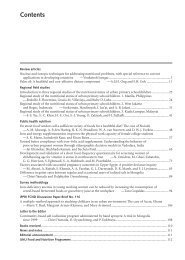Good companies - Positive Deviance Initiative
Good companies - Positive Deviance Initiative
Good companies - Positive Deviance Initiative
You also want an ePaper? Increase the reach of your titles
YUMPU automatically turns print PDFs into web optimized ePapers that Google loves.
check if patients were in fact purchasing the medicines. This verification served<br />
to cross-check the patients recollection. The initial phone calls were quite<br />
revealing. There was an instance where one patient, a gentleman on a blood<br />
thinner, was asked if he was taking his medication every other day. He said, of<br />
course. On probing by the nurse, the patient reveals that he was taking the<br />
medicine every Monday, Wednesday, and Friday. But what about on the<br />
weekend, the nurse responded. To which the man replied, weekends don’t count,<br />
it’s only every other day – by which he understood every other weekday, but not<br />
on weekends! Instead of taking the medication on average 15 times a month, he<br />
was taking it approximately 12 times a month or 80% of the required dosage. Dr.<br />
Cusano mentions another instance in which a patient had instructions on a<br />
discharge sheet “Take Q6H” as instructions for a specific pain medication. The<br />
patient did not read the label on the pill bottle, but assumed that Q6H on the<br />
discharge sheet meant to take the medication “six times” a day. (Cusano, 2005a)<br />
Jerry and Monique Sternin made six visits to the hospital between October and<br />
May. Facilitators spent between 85-100 hours on the intervention, not to mention<br />
the numerous hours spent by nurses making calls, as well as staff meetings and<br />
work sessions. And it was important for the staff to take the time. While everyone<br />
in the hospital understood the problem of medication reconciliation, there was<br />
poor awareness of the extent of the problem and its severity. Criticality of the<br />
issue promotes change, and the personal involvement of the nurses in the calling<br />
and in the overall intervention helped to raise awareness in the hospital: “Yes, we<br />
do have a problem here!”<br />
While there wasn’t a project plan as such, the timeline for the bulk of the<br />
intervention has been reconstructed by Ms. Potrepka. This timeline is not all<br />
inclusive, but does capture the major milestones along the way.<br />
R.M. Saco p. 38
















